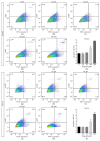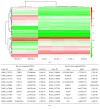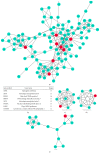Effects of Propofol Treatment in Neural Progenitors Derived from Human-Induced Pluripotent Stem Cells
- PMID: 29119024
- PMCID: PMC5651106
- DOI: 10.1155/2017/9182748
Effects of Propofol Treatment in Neural Progenitors Derived from Human-Induced Pluripotent Stem Cells
Abstract
Propofol is an intravenous anesthetic that has been widely used in clinics. Besides its anesthetic effects, propofol has also been reported to influence the regulation of the autonomic system. Controversies exist with regard to whether propofol exposure is safe for pregnant women and young children. In this work, human-induced pluripotent stem cell- (hiPSC-) derived neural progenitor cells (NPCs) were treated with propofol at 20, 50, 100, or 300 μM for 6 h or 24 h, and acute and subacute cell injury, cell proliferation, and apoptosis were evaluated. Comparison of genome-wide gene expression profiles was performed for treated and control iPSC-NPCs. Propofol treatment for 6 h at the clinically relevant concentration (20 or 50 μM) did not affect cell viability, apoptosis, or proliferation, while propofol at higher concentration (100 or 300 μM) decreased NPC viability and induced apoptosis. In addition, 20 μM propofol treatment for 6 h did not alter global gene expression. In summary, propofol treatment at commonly practiced clinical doses for 6 h did not have adverse effects on hiPSC-derived NPCs. In contrast, longer exposure and/or higher concentration could decrease NPC viability and induce apoptosis.
Figures







Similar articles
-
Protective effect of acetyl-L-carnitine on propofol-induced toxicity in embryonic neural stem cells.Neurotoxicology. 2014 May;42:49-57. doi: 10.1016/j.neuro.2014.03.011. Epub 2014 Apr 2. Neurotoxicology. 2014. PMID: 24704589
-
Prolonged Treatment with Propofol Transiently Impairs Proliferation but Not Survival of Rat Neural Progenitor Cells In Vitro.PLoS One. 2016 Jul 5;11(7):e0158058. doi: 10.1371/journal.pone.0158058. eCollection 2016. PLoS One. 2016. PMID: 27379684 Free PMC article.
-
Mitochondrial biogenesis and neural differentiation of human iPSC is modulated by idebenone in a developmental stage-dependent manner.Biogerontology. 2017 Aug;18(4):665-677. doi: 10.1007/s10522-017-9718-4. Epub 2017 Jun 22. Biogerontology. 2017. PMID: 28643190 Free PMC article.
-
Down-regulation of microRNA-21 is involved in the propofol-induced neurotoxicity observed in human stem cell-derived neurons.Anesthesiology. 2014 Oct;121(4):786-800. doi: 10.1097/ALN.0000000000000345. Anesthesiology. 2014. PMID: 24950164 Free PMC article.
-
Protective Effects of Xenon on Propofol-Induced Neurotoxicity in Human Neural Stem Cell-Derived Models.Mol Neurobiol. 2020 Jan;57(1):200-207. doi: 10.1007/s12035-019-01769-5. Mol Neurobiol. 2020. PMID: 31578707
Cited by
-
Alzheimer's Disease Presenilin-1 Mutation Sensitizes Neurons to Impaired Autophagy Flux and Propofol Neurotoxicity: Role of Calcium Dysregulation.J Alzheimers Dis. 2019;67(1):137-147. doi: 10.3233/JAD-180858. J Alzheimers Dis. 2019. PMID: 30636740 Free PMC article.
-
A Comparative Study of Common Anesthetics Propofol, Sevoflurane, Isoflurane and Ketamine on Lipid Membrane Fluidity.Int J Mol Sci. 2025 Feb 5;26(3):1337. doi: 10.3390/ijms26031337. Int J Mol Sci. 2025. PMID: 39941104 Free PMC article.
-
Effect of Laminin Derived Peptides IKVAV and LRE Tethered to Hyaluronic Acid on hiPSC Derived Neural Stem Cell Morphology, Attachment and Neurite Extension.J Funct Biomater. 2020 Mar 6;11(1):15. doi: 10.3390/jfb11010015. J Funct Biomater. 2020. PMID: 32155839 Free PMC article.
-
Studying Human Neurological Disorders Using Induced Pluripotent Stem Cells: From 2D Monolayer to 3D Organoid and Blood Brain Barrier Models.Compr Physiol. 2019 Mar 14;9(2):565-611. doi: 10.1002/cphy.c180025. Compr Physiol. 2019. PMID: 30873582 Free PMC article. Review.
-
The Effects of Propofol on a Human in vitro Blood-Brain Barrier Model.Front Cell Neurosci. 2022 May 11;16:835649. doi: 10.3389/fncel.2022.835649. eCollection 2022. Front Cell Neurosci. 2022. PMID: 35634467 Free PMC article.
References
MeSH terms
Substances
LinkOut - more resources
Full Text Sources
Other Literature Sources
Molecular Biology Databases

